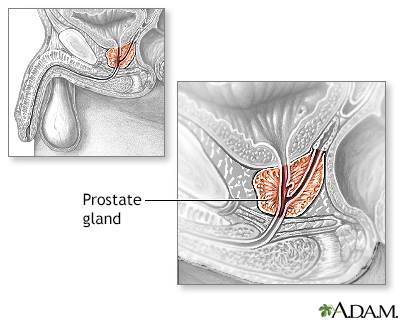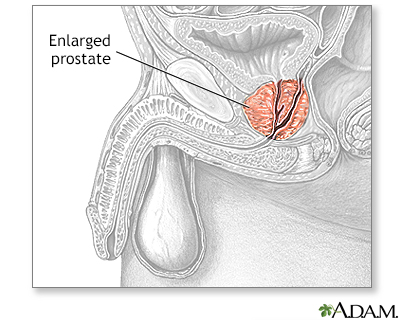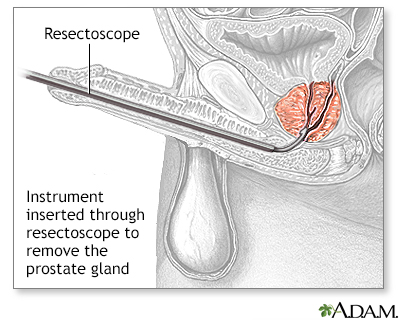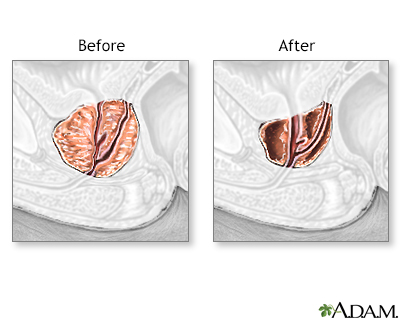Enlarged prostate
BPH; Benign prostatic hyperplasia (hypertrophy); Prostate - enlargedThe prostate is a gland that produces some of the fluid that carries sperm during ejaculation. The prostate gland surrounds the urethra, the tube through which urine passes out of the body.
An enlarged prostate means the gland has grown bigger. Prostate enlargement happens to almost all men as they get older.
An enlarged prostate is often called benign prostatic hyperplasia (BPH). It is not cancer, and it does not raise your risk for prostate cancer.
Causes
The actual cause of prostate enlargement is unknown. Factors linked to aging and changes in the cells of the testicles may have a role in the growth of the gland, as well as testosterone levels. Men who have had their testicles removed at a young age (for example, as a result of testicular cancer) do not develop BPH.
Also, if the testicles are removed after a man develops BPH, the prostate begins to shrink in size. However, this is not a standard treatment for an enlarged prostate.
Some facts about prostate enlargement:
- The likelihood of developing an enlarged prostate increases with age.
- BPH is so common that it has been said all men will have an enlarged prostate if they live long enough.
- A small amount of prostate enlargement is present in many men over age 40. More than 90% of men over age 80 have the condition.
- No risk factors have been identified, other than having normally-functioning testicles.
Symptoms
Less than half of all men with BPH have symptoms of the disease. Symptoms may include:
- Dribbling at the end of urinating
- Inability to urinate (urinary retention)
- Incomplete emptying of your bladder
-
Incontinence
Incontinence
Urinary (or bladder) incontinence occurs when you are not able to keep urine from leaking out of your urethra. The urethra is the tube that carries ...
 ImageRead Article Now Book Mark Article
ImageRead Article Now Book Mark Article -
Needing to urinate 2 or more times per night
Needing to urinate 2 or more times per ...
Normally, the amount of urine your body produces decreases at night. This allows most people to sleep 6 to 8 hours without having to urinate. Some p...
 ImageRead Article Now Book Mark Article
ImageRead Article Now Book Mark Article -
Pain with urination or bloody urine (these may indicate infection)
Pain with urination
Painful urination is any pain, discomfort, or burning sensation when passing urine.
 ImageRead Article Now Book Mark Article
ImageRead Article Now Book Mark ArticleBloody urine
Blood in your urine is called hematuria. The amount may be very small and only detected with urine tests or under a microscope. In other cases, the...
 ImageRead Article Now Book Mark Article
ImageRead Article Now Book Mark Article -
Slowed or delayed start of the urinary stream
Slowed or delayed start of the urinary ...
Difficulty starting or maintaining a urine stream is called urinary hesitancy.
 ImageRead Article Now Book Mark Article
ImageRead Article Now Book Mark Article - Straining to urinate
-
Strong and sudden urge to urinate
Strong and sudden urge to urinate
Frequent urination means needing to urinate more often than usual. Urgent urination is a sudden, strong need to urinate. This causes a discomfort i...
 ImageRead Article Now Book Mark Article
ImageRead Article Now Book Mark Article - Weak urine stream
Exams and Tests
Your health care provider will ask questions about your medical history. A digital rectal exam will also be done to feel the prostate gland. Other tests may include:
Digital rectal exam
A digital rectal exam is an exam of the lower rectum. Your health care provider uses a gloved, lubricated finger to check for any abnormal findings....

- Urine flow rate
- Post-void residual urine test to see how much urine is left in your bladder after you urinate (usually done by ultrasound)
- Pressure-flow studies to measure the pressure in the bladder as you urinate
-
Urinalysis to check for blood or infection
Urinalysis
Urinalysis is the physical, chemical, and microscopic examination of urine. It involves a number of tests to detect and measure various compounds th...
 ImageRead Article Now Book Mark Article
ImageRead Article Now Book Mark Article -
Urine culture to check for infection
Urine culture
A urine culture is a lab test to check for bacteria or other germs in a urine sample. It can be used to check for a urinary tract infection in adults...
 ImageRead Article Now Book Mark Article
ImageRead Article Now Book Mark Article - Prostate-specific antigen (PSA) blood test to screen for prostate cancer
PSA
Prostate-specific antigen (PSA) is a protein produced by prostate cells. The PSA test is done to help screen for and monitor prostate cancer in men....
 ImageRead Article Now Book Mark Article
ImageRead Article Now Book Mark Article -
Cystoscopy
Cystoscopy
Cystoscopy is a surgical procedure. This is done to see the inside of the bladder and urethra using a thin, lighted tube.
 ImageRead Article Now Book Mark Article
ImageRead Article Now Book Mark Article -
Blood urea nitrogen (BUN) and creatinine tests to check for reduced kidney function
Blood urea nitrogen (BUN)
BUN stands for blood urea nitrogen. Urea nitrogen is what forms when protein breaks down. A test can be done to measure the amount of urea nitrogen ...
 ImageRead Article Now Book Mark Article
ImageRead Article Now Book Mark Article
You may be asked to fill out a form to rate how bad your symptoms are and how much they affect your daily life. Your provider can use this score to judge if your condition is getting worse over time.
Treatment
The treatment you choose will be based on how bad your symptoms are and how much they bother you. Your provider will also take into account other medical problems you may have.
Treatment options include "watchful waiting," lifestyle changes, medicines, or surgery.
If you are over 60, you are more likely to have symptoms. But many men with an enlarged prostate have only minor symptoms. Self-care steps are often enough to make you feel better.
If you have BPH, you should have a yearly assessment to monitor your symptoms and see if you need changes in treatment.
SELF-CARE
For mild symptoms:
- Urinate when you first get the urge. Also, go to the bathroom on a timed schedule, even if you don't feel a need to urinate.
- Avoid alcohol and caffeine, especially after dinner.
- Do not drink a lot of fluid all at once. Spread out fluids during the day. Avoid drinking fluids within 2 hours of bedtime.
- Try not to take over-the-counter cold and sinus medicines that contain decongestants or antihistamines. These medicines can increase BPH symptoms.
- Keep warm and exercise regularly. Cold weather and lack of physical activity may worsen symptoms.
- Reduce stress. Nervousness and tension can lead to more frequent urination.
MEDICINES
Alpha-1 blockers are a class of medicines, some of which have been used to treat high blood pressure. These medicines relax the muscles of the bladder neck and prostate. This allows easier urination. Most people who take alpha-1 blockers notice improvement in their symptoms, usually within 3 to 7 days after starting the medicine.
Finasteride and dutasteride lower levels of hormones produced by the prostate. These medicines also reduce the size of the gland, increase urine flow rate, and decrease symptoms of BPH. You may need to take these medicines for 3 to 6 months before you notice symptoms getting better. Possible side effects include decreased sex drive and impotence.
Impotence
An erection problem occurs when a man cannot get or keep an erection that is firm enough for intercourse. You may not be able to get an erection at ...

Antibiotics may be prescribed to treat chronic prostatitis (inflammation of the prostate), which may occur with BPH. BPH symptoms may improve in some men after a course of antibiotics.
Watch out for medicines that may make your symptoms worse such as decongestants, antihistamines, diuretics, and certain antidepressants.
Medicines that may make your symptoms w...
Your health care provider has told you that you have an enlarged prostate gland. Here are some things to know about your condition.

SAW PALMETTO
Many herbs have been tried for treating an enlarged prostate. Many men use saw palmetto to ease symptoms. Some studies have shown that it may help with symptoms, but results are mixed, and more research is needed. If you use saw palmetto and think it works, ask your provider if you should still take it.
SURGERY
Prostate surgery may be recommended if you have:
- Incontinence
- Recurrent blood in the urine
- Inability to fully empty the bladder (urinary retention)
- Recurrent urinary tract infections
Urinary tract infections
A urinary tract infection, or UTI, is an infection of the urinary tract. The infection can occur at different points in the urinary tract, including...
 ImageRead Article Now Book Mark Article
ImageRead Article Now Book Mark Article - Decreasing kidney function
-
Bladder stones
Bladder stones
Bladder stones are hard buildups of minerals. These form in the urinary bladder.
 ImageRead Article Now Book Mark Article
ImageRead Article Now Book Mark Article - Bothersome symptoms not responding to medicines
The choice of which surgical procedure is recommended is most often based on the severity of your symptoms and the size and shape of your prostate gland. Most men who have prostate surgery have improvement in urine flow rates and symptoms.
Transurethral resection of the prostate (TURP): This is the most common and most proven surgical treatment for BPH. TURP is performed by inserting a scope through the penis and removing the prostate piece by piece.
Transurethral resection of the prostate
Transurethral resection of the prostate (TURP) is a surgery to remove the inside part of the prostate gland. It is done in order to treat symptoms o...

Simple prostatectomy: This is a procedure to remove the inside part of the prostate gland. It is done through a surgical cut in your lower belly. This treatment is most often done on men who have very large prostate glands.
Simple prostatectomy
Simple prostate removal is a procedure to remove the inside part of the prostate gland to treat an enlarged prostate. It is done through a surgical ...
Other less-invasive procedures use heat or a laser to destroy prostate tissue. Another less-invasive procedure works by "tacking" the prostate open without removing or destroying tissues. None have been proven to be better than TURP. People who receive these procedures are more likely to need surgery again after 5 or 10 years. However, these procedures may be a choice for:
Less-invasive procedures
Minimally invasive prostate resection is surgery to remove part of the prostate gland, to treat an enlarged prostate. The surgery will improve the f...
- Younger men (many of the less-invasive procedures carry a lower risk for impotence and incontinence than TURP, although the risk with TURP is not very high)
- Older people
- People with severe medical conditions, including uncontrolled diabetes, cirrhosis, alcoholism, psychosis, and serious lung, kidney, or heart disease
Diabetes
Diabetes is a long-term (chronic) disease in which the body cannot regulate the amount of sugar in the blood.
 ImageRead Article Now Book Mark Article
ImageRead Article Now Book Mark ArticleCirrhosis
Cirrhosis is scarring of the liver and poor liver function. It is the last stage of chronic liver disease.
 ImageRead Article Now Book Mark Article
ImageRead Article Now Book Mark ArticlePsychosis
Psychosis occurs when a person loses contact with reality. The person may: Have false beliefs about what is taking place, or who one is (delusions)S...
Read Article Now Book Mark ArticleHeart disease
Coronary heart disease is a narrowing of the blood vessels that supply blood and oxygen to the heart. Coronary heart disease (CHD) is also called co...
 ImageRead Article Now Book Mark Article
ImageRead Article Now Book Mark Article - Men who are taking blood-thinning medicines
- Men who are otherwise at an increased surgical risk
Support Groups
Some men may find it helpful to take part in a BPH support group.
BPH support group
The following organizations provide information on benign prostatic hyperplasia (prostate enlargement):American Academy of Family Physicians -- famil...

Possible Complications
Men who have had BPH for long time with slowly worsening symptoms may develop:
- Sudden inability to urinate (urinary retention)
-
Urinary tract infections
Urinary tract infections
A urinary tract infection, or UTI, is an infection of the urinary tract. The infection can occur at different points in the urinary tract, including...
 ImageRead Article Now Book Mark Article
ImageRead Article Now Book Mark Article - Urinary stones
- Damage to the kidneys
- Blood in the urine
BPH may come back over time, even after having surgery.
When to Contact a Medical Professional
Contact your provider right away if you have:
- Less urine than usual
-
Fever or chills
Fever
Fever is the temporary increase in the body's temperature in response to a disease or illness. A child has a fever when the temperature is at or abov...
 ImageRead Article Now Book Mark Article
ImageRead Article Now Book Mark ArticleChills
Chills refers to feeling cold after being in a cold environment. The word can also refer to an episode of shivering along with paleness and feeling ...
 ImageRead Article Now Book Mark Article
ImageRead Article Now Book Mark Article - Back, side, or abdominal pain
- Blood or pus in your urine
Also contact your provider if:
- Your bladder does not feel completely empty after you urinate.
- You take medicines that may cause urinary problems, such as diuretics, antihistamines, antidepressants, or sedatives. Do not stop or change your medicines without talking to your provider.
- You have tried self-care steps for 2 months and symptoms have not improved.
References
Capogrosso P, Pozzi E, Salonia A, Montorsi F. Evaluation and nonsurgical management of benign prostatic hyperplasia. In: Domochowski RR, Kavoussi LR, Peters CA, et al, eds. Campbell-Walsh-Wein Urology. 13th ed. Philadelphia, PA: Elsevier; 2026:chap 150.
Cruz F, Michel MC, Igawa Y. Pharmacologic management of lower urinary tract storage and emptying failure. In: Domochowski RR, Kavoussi LR, Peters CA, et al, eds. Campbell-Walsh-Wein Urology. 13th ed. Philadelphia, PA: Elsevier; 2026:chap 113.
Kaplan SA. Benign prostatic hyperplasia and prostatitis. In: Goldman L, Cooney KA, eds. Goldman-Cecil Medicine. 27th ed. Philadelphia, PA: Elsevier; 2024:chap 114.
National Institute of Diabetes and Digestive and Kidney Diseases website. Enlarged prostate (benign prostatic hyperplasia). www.niddk.nih.gov/health-information/urologic-diseases/prostate-problems/prostate-enlargement-benign-prostatic-hyperplasia. Updated June 2024. Accessed July 2, 2025.
Sandhu JS, Bixler BR, Dahm P, et al. Management of lower urinary tract symptoms attributed to benign prostatic hyperplasia (BPH): AUA Guideline Amendment 2023. J Urol. 2024;211(1):11-19. PMID: 37706750 pubmed.ncbi.nlm.nih.gov/37706750/.
-
Male reproductive anatomy - illustration
The male reproductive structures include the penis, the scrotum, the testicles (testes), the epididymis, the seminal vesicles, and the prostate.
Male reproductive anatomy
illustration
-
BPH - illustration
Benign prostatic hyperplasia (BPH) is a non-cancerous enlargement of the prostate gland, commonly found in men over the age of 50.
BPH
illustration
-
Transurethral Resection of the Prostate (TURP) - Series
Presentation
-
Male reproductive anatomy - illustration
The male reproductive structures include the penis, the scrotum, the testicles (testes), the epididymis, the seminal vesicles, and the prostate.
Male reproductive anatomy
illustration
-
BPH - illustration
Benign prostatic hyperplasia (BPH) is a non-cancerous enlargement of the prostate gland, commonly found in men over the age of 50.
BPH
illustration
-
Transurethral Resection of the Prostate (TURP) - Series
Presentation
Review Date: 7/1/2025
Reviewed By: Kelly L. Stratton, MD, FACS, Associate Professor, Department of Urology, University of Oklahoma Health Sciences Center, Oklahoma City, OK. Also reviewed by David C. Dugdale, MD, Medical Director, Brenda Conaway, Editorial Director, and the A.D.A.M. Editorial team.









